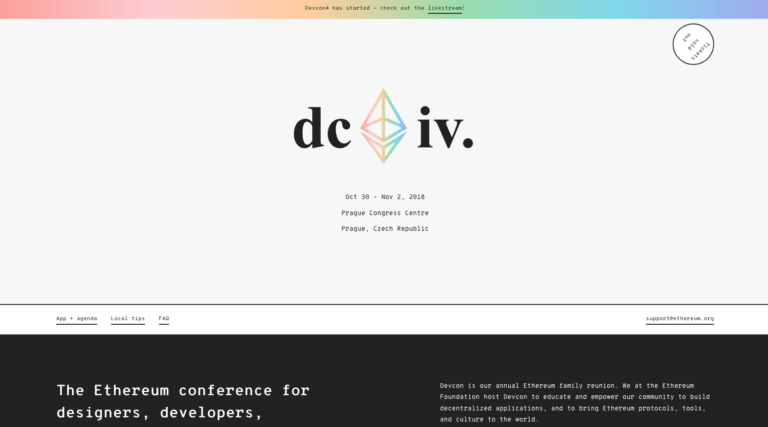On Wednesday (31 October 2018), Vitalik Buterin, while delivering the keynote speech at the 4th annual “builders” conference (Devcon4), held this year in Prague, Czech Republic, said that Ethereum 2.0 was “really not so far away.”
Vitalik started by listing what will be in Ethereum 2.0 (“Serenity”), features that Ethereum’s core development team has been “talking about for several years”, “researching for several years”, and “actively building for several years”:
- Proof of stake (“Casper”)
- Scalability (“sharding”)
- Virtual Machine Improvements (EWASM)
- Improvements to cross-contract logic
- Improvements to protocol economics
The Long Road to Ethereum 2.0 (“Serenity”)
It all began on 15 January 2014 with a post by Vitalik for the Ethereum blog titled “Slasher: A Punitive Proof-of-Stake Algorithm”), in which he described an algorithm called Slasher. Right in the first paragraph, he explained the purpose of Slasher:
“The purpose of this post is not to say that Ethereum will be using Slasher in place of Dagger as its main mining function. Rather, Slasher is a useful construct to have in our war chest in case proof of stake mining becomes substantially more popular or a compelling reason is provided to switch.”
During the summer of 2014, various ideas for improving scalability were explored and eventually abandoned: “Proof of Proof of work”; Hub-and-spoke chains; and Hypercube chains. However, there was still some progress made, such as becoming certain that “algorithms with much stronger properties than existing PoS are possible.”
During 2015 and 2016, while research on Casper and the virtual machine was going on, there were “a series of abortive attempts at solving the core problems.”
Then, in 2017, “The Industrious Age” began. During this period, various strands of research were going on:
- “Minimal slashing”
- “Conditions (February 2017)”
- “Casper FFG (Fall 2017)”
- “Casper CBC (2017–2018)”
- “Erasure coding data availability “
Verison 1.0 of the Casper FFG paper (“Casper the Friendly Finality Gadget”) was published in October 2017. This introduced Casper, “a proof of stake-based finality system which overlays an existing proof of work blockchain.”
At last year’s Devcon conference, Vitalik introduced a new sharding design, which essentially kept the main chain, and created sharding as a kind of layer two system on top of the existing main chain, the idea being that sharding would get upgraded to layer one once it got “solid enough.”
In December 2017, Vlad Zamfir published the Casper CBC paper (titled “Casper the Firendly Ghost: A ‘Correct-by-Construction’ Blockchain Consensus Protocol”).
In June 2018, the team made the decision to merge Casper and sharding in Ethereum 2.0 (Serenity). Serenity is “a new blockchain, though with a link to the existing PoW chain.” The “long long term goal” (which has not been finalized yet) is that once this Proof-of-Stake system is stable enough, “all of the applications on the existing blockchain can be sort of folded onto a contract on one shard of a new system that would kind of be an EVM interpreter written in EWASM.”
Vitalik said that Serenity is “The World Computer” as “it’s really meant to be,” even though it is still decentralized. The expected phases are:
- Phase 0: “Beacon chain PoS”
- Phase 1: “Shards as data chains”
- Phase 2: “Enable state transitions (EWASM)”
- Phase 3 (and beyond): “Iterate, improve, add tech”
The expected features are:
- “Pure PoS consensus”
- “Faster time to synchronous confirmation (8–16 seconds)”
- “‘Economic Finality’ (10–20 minutes”)
- “Fast VM execution via EWASM”
- ” ~1000x Higher Scalability”
As for post-Serenity innovations, the team expects to deliver:
- “Layer 2 execution engines” (for privacy, cross-shard transactions, and “semi-private chains”)
- “Proof of stake improvements”
- “Upgrade to STARKs”
- “Stronger base-layer cross-shard transactions?”
- “Even faster single-confirmations?”
Medium term goals for Serenity include:
- “Eventually stablize at least the functionality of layer 1”
- “Think about issuance, fees…”
- “Agree on the guarantee that people expect from the protocol”
- “Think about governance”
As for what’s expected to occur before the big launch of Serenity, first, the protocol spec needs to be stabilized. Next, the development and testing of the various implementations of Ethereum 2.0 need to continue. Also, more work is expected to occur on cross-client testnets. And finally, there will need to be several security audits before the launch can take place. As for when the launch would take place, all Vitalik would say was ““really not so far away.”
Featured Image Courtesy of the Ethereum Foundation









